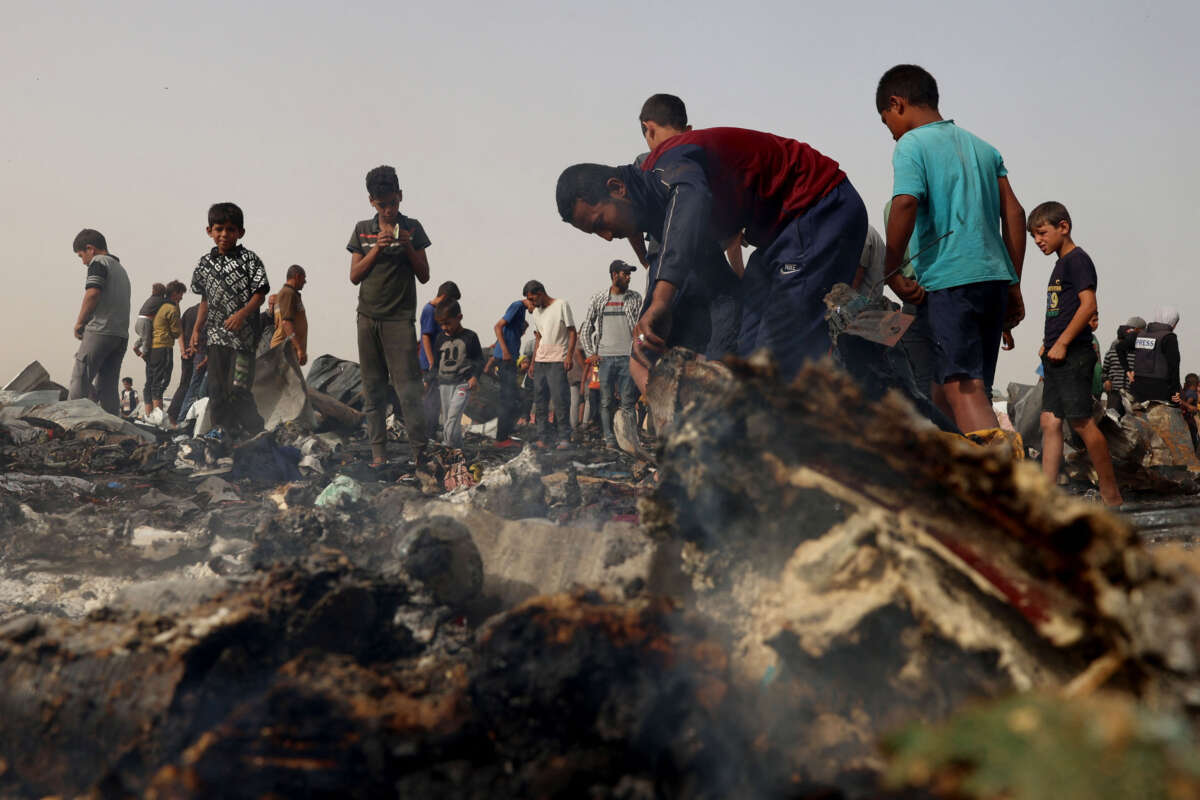Support justice-driven, accurate and transparent news — make a quick donation to Truthout today!
Israel used U.S.-made bombs in a brutal attack on a displacement camp in Rafah that killed 45 Palestinians in May, a new investigation reveals.
According to The New York Times, on May 26, Israel deployed two 250-pound bombs — Boeing’s GBU-39 “small diameter” bombs that caused a blast that could kill and injure in a 570 foot radius — on sheds built for residential purposes in Kuwaiti Al-Salam Camp 1. There were roughly 60 camps within 500 feet of the blast, according to the investigation.
The attack was horrific. The blast and ensuing fire killed 45 Palestinians, including eight children, and injured 249 others. Images emerged of a decapitated baby and families pulling charred bodies out of the rubble as a blaze raged on across what was left of the tents. There was blood everywhere, and one doctor said the area smelled of “burned flesh.”
One 37-year-old man, Saleh Mohammed al-Hila, had been sheltering in the camp with his family since March, with his sister and mother in another tent nearby. His family had already been displaced four times. On the day of the bombing, he returned from his sister’s tent to his own for evening prayers, and was going to bring his 2-year-old son to see his grandmother.
Then the bombs hit, killing Al-Hila’s mother, sister, 15-year-old niece and 1-year old nephew. The family was only able to identify the baby by the color of his trousers, the Times reported.
“I feel I am dying and having a nightmare I cannot forget or get out of,” al-Hila told The New York Times.
The densely-populated camp in southern Gaza, just north of Rafah, was built in Tal Al-Sultan refugee camp area just months ago for Palestinians who have been displaced, many multiple times, throughout Israel’s genocide. It was located close to humanitarian warehouses and health centers, and has now been largely evacuated due to the attack.
The camp was in an area that did not receive evacuation orders ahead of Israel’s invasion of Rafah in May. A Times analysis of the location of the bombing, which Israeli forces claimed killed two Hamas leaders, concluded that Israel had likely not taken “adequate care to safeguard civilians,” as it is obligated to do under international law.
One organization that was aiding in running the camp, Al-Salam Association for Humanitarian and Charitable Works, said not only were Israeli officials aware of the camp, but they had also had a say in its location when it was built.
U.S. law prohibits U.S. weapons from being used to violate international law. But, despite constantly mounting evidence that Israel has been using U.S. weapons to indiscriminately bomb civilians in its campaign to exterminate Palestinians in Gaza, the Biden administration has refused to stop sending weapons to Israel.
Another report, released on Thursday, also found that U.S. weapons were likely used in a possible war crime in November. According to EuroMed Human Rights Monitor, an Israeli attack on a residential area in Jabalia refugee camp on November 1, which killed 120 people, was likely carried out by U.S. bombs. Israeli aircraft dropped 6 to 8 bombs on the area, targeting residential buildings and a kindergarten.
The analysis found that an Israeli attack the previous day was likely carried out with 2,000 pound JDAMs, and that the November 1 attack carried similarities in terms of size, outcome and the “patterns of destruction” caused by the blasts. Overall, the two attacks killed 195 Palestinians, wounded at least 777 more, and buried about 120 people under the rubble, Palestinian officials said.
“The attack was either deliberately direct or excessively indiscriminate, all of which are classified as full-fledged war crimes under the Rome Statute,” EuroMed Monitor wrote.
Press freedom is under attack
As Trump cracks down on political speech, independent media is increasingly necessary.
Truthout produces reporting you won’t see in the mainstream: journalism from the frontlines of global conflict, interviews with grassroots movement leaders, high-quality legal analysis and more.
Our work is possible thanks to reader support. Help Truthout catalyze change and social justice — make a tax-deductible monthly or one-time donation today.
